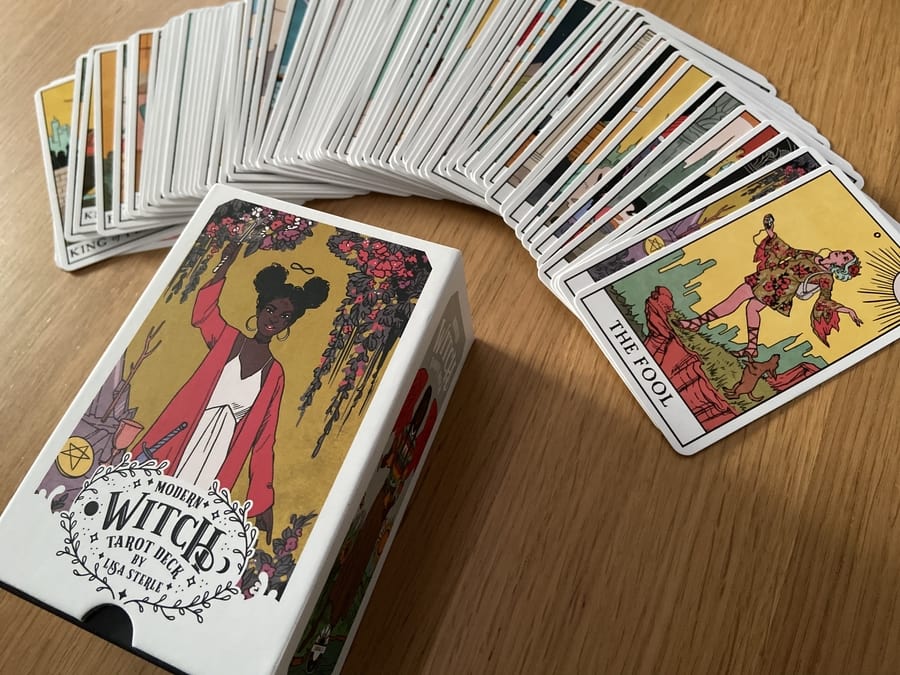
I recently opened a new tarot deck I had bought and encountered inside some spectacularly slippery tarot cards. So it got me researching, is there a way to make tarot cards less slippery?
To make your tarot cards less slippery, you will need to “break-in” the deck. This process is a combination of handling, shuffling, and using the cards extensively in a short period of time. The process will break the glossy coating and the cards’ surface microscopically, which will add friction to your cards.
There are some things to take into account when you are breaking-in the deck. If you are not an experienced card shuffler, you will want to avoid bending your new cards. I will demonstrate in the following some of the techniques you can use to make your tarot cards less slippery. I also found an interesting powder that magicians use on their cards to add some lifespan on their cards and have more consistent control when handling the cards. Let’s take a look.
Why are new Tarot Cards slippery?
Oh, the excitement when you get your hands on a new deck of tarot cards. Breaking the cellophane protected packaging, getting the first sniff of the fresh ink, and touching the cards’ unbroken surface are things that excite me every time.
But when you start handling them, they start jumping out of my hands like they want to escape. They seem to have their own will to go anywhere else but stay in my hands. In addition to being annoying, dropping the cards around can damage and dirty them, so I want to handle my new cards comfortably.
Some tarot decks will be slippery when you first start using them. The slick surface of tarot cards is a result of the material or coating that has been used to manufacture the cards. Tarot cards are typically made of either plastic or layered paper. Cards made of plastic tend to be more slippery than paper cards. They are also more robust and more durable, which also makes them a bit more expensive.
Most commonly, the stock used to make tarot cards is from layered paper. It is created by gluing several layers of paper and pressing them together under high pressure. The layered paper is more durable than regular paper, but it is cheaper than plastic. Therefore many of the more affordable decks are made from this material. A glossy coating can be used on the paper cards to achieve a plastic-like finish.
This coating will often make the paper deck more slippery than paper cards without a finish. However, it is sometimes a bit of a gamble with the finish as sometimes it can also make the cards stick to each other more. But whether the new cards are slippery or sticky, the one thing that will help to make the deck consistent and more comfortable to handle is “breaking-in” the deck.
How do you make tarot cards less slippery?
There are a couple of ways to make your cards less slippery. The first and recommended way is to use the cards. Over time, the deck will start feeling more comfortable in your hands and also start losing some of its slipperiness naturally. But to speed up the natural process, you can use a method of “Breaking in” the deck. Another technique that I will talk about includes the use of powder to influence the cards’ performance.
Method 1 – “Breaking-in” the tarot deck
The best way to get your tarot cards feeling comfortable on your hands is to use them. And, this is what breaking-in the cards is all about. But instead of taking the time and using them traditionally by laying out tarot spreads and reading the cards, you are now concentrating just on handling and shuffling the cards.
When you are handling and shuffling the deck, your hands will start to “get a feel” for the cards. You will begin to feel more comfortable with them on your hands. Another thing that will happen when the cards are in use, the cards’ surfaces rub against one another, and the shiny coating on the cards’ surface will start to wear off microscopically. These small fractures on the card’s surface will create friction between the cards and make them less slippery.
“Breaking-in” the deck is a method that different card players and magicians use on their playing cards to get a consistent feel for their cards.
So how to break-in a deck? Shuffle, mix and handle your deck in general. When you are doing this, you are always touching the cards and making the cards rub each other or your table’s surface.
Shuffling tarot cards can be a bit different than shuffling regular playing cards due to their larger size. Some tarot readers also shy away from some card game shuffling techniques like the “riffle shuffle” because they involve bending the tarot cards. There is a real danger of permanently damaging the cards with some of those methods if you don’t know how to perform them correctly, so don’t practice those with your new deck.
I would say that the safest technique to break in the deck is to use “the overhand shuffle” or “the wash.”
- Overhand shuffle: Here, you start with the deck in your right hand (if you are right-handed), and you start throwing small chunks of the deck into your left hand. You can assist this with your left thumb by pealing off small portions of the deck when you bring the deck to your left hand’s palm.
- Wash: Now sometimes, this is called the granny shuffle or smushing or smooshing shuffle. It is a technique that even your granny can do, so it is safe to say that it is easy. All you have to do is scatter the cards on the table and start spreading them around randomly. Make a messy pile and rub them around all over the place. You can bring the cards together into a stack and repeat it a few times. Just make sure that you don’t drop your cards off the table, and you don’t smush them together too violently when you are mixing.
By shuffling the cards, you can expect to start seeing results already in about 15 minutes. The more you do this, the more comfortable and less slippery they will feel.
Method 2 – Powders to influence the cards
Another method worth mentioning is a couple of different powders that you can gently apply to your cards. Now, this is something that I have not yet tried personally, so don’t take my word for it. I don’t recommend you to go and try these on your cards unless you don’t mind taking the risk of damaging your cards. I personally just found out about this when I was researching the subject, but I might give them a try later on.
The first of the powders that we’ll talk about is fanning powder. This powder is something that magicians use to improve the performance and consistency of their cards. The deck’s consistent performance is essential for magicians as they perform card tricks that require skill and precision in front of live audiences.
A key ingredient in most fanning powders is zinc stearate, which has non-sticking properties. Therefore, it can also be used if your deck is a bit older and feel that the cards have too much friction. Interestingly enough, in addition to giving the cards a consistent feel over time, the fanning powder also helps protect the cards and increase their lifespan.
Another powder that some card players seem to use is talcum powder. One of talcum powders properties is that it absorbs moisture. Initially, it will make the cards more slippery, but it becomes stickier as it takes on the moisture from the air. This property makes this interesting because it will create more friction between the cards and take away your cards’ problem of being too slippery.
